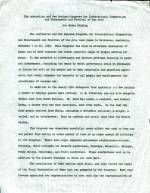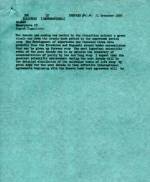|
Through 1959, the Paulings worked tirelessly to keep the pro-peace momentum going.
The couple traveled from Canada to New Zealand giving talks on the arms race, with
Ava Helen now starting to give her own speeches to groups including the Women’s International
League for Peace and Freedom. Her talks were warmly received, and soon she was making
almost as many speeches as her husband.
In the meantime, the US and USSR had started talks in Geneva aimed at devising a ban
on all nuclear testing, in the air, on the sea, and underground. Everything seemed
to be moving in a positive direction -- until the fall of 1959, when the Geneva talks
stalled. Pauling believed the reason was Edward Teller, who had announced that there
was a glitch in monitoring compliance with a test ban. Teller asserted that underground
bomb tests could be hidden, masked from detection, if they were conducted in a large
enough cavern. His "Big Hole" theory threw a monkey wrench into the delicate negotiations
for compliance oversight during a test ban, and became an impediment to further talks.
At the end of 1959 the moratorium on testing expired. It was an unhappy New Year for
the Paulings. They retreated to their seaside house on the rugged coast of Big Sur
to rest and plan their next steps.
|
|
Click images to enlarge

"The Australian and New Zealand Congress for International Cooperation and Disarmament
and Festival of the Arts." November 1959.

No Title. [re: the greatest scientific achievement of the 1950s and Pauling's hopes
for the 1960s], December 21, 1959.
"You can trust a nation to adhere to any agreement for so long as that agreement continues
to benefit the nation concerned. So long as they themselves can benefit, they will
continue to adhere to an agreement. The entire world would benefit by an agreement
to suspend nuclear explosions -- and would continue to benefit from such an accord."
|

